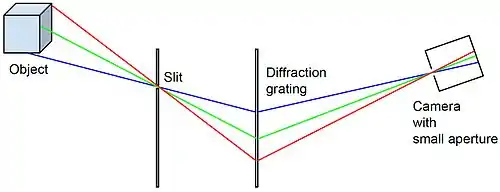Spatiospectral scanning
Spatio-spectral scanning[1] is one of four techniques for hyperspectral imaging, the other three being spatial scanning,[2] spectral scanning [3] and non-scanning, or snapshot hyperspectral imaging.
The technique was designed to put into practice the concept of 'tilted sampling' of the hyperspectral data cube, which had been deemed difficult to achieve.[4] Spatio-spectral scanning yields a series of thin, diagonal slices of the data cube. Figuratively speaking, each acquired image is a 'rainbow-colored' spatial map of the scene. More precisely, each image represents two spatial dimensions, one of which is wavelength-coded. To acquire the spectrum of a given object point, scanning is needed.
Spatio-spectral scanning combines some advantages of spatial and spectral scanning: Depending on the context of application, one can choose between a mobile and a stationary platform. Moreover, each image is a spatial map of the scene, facilitating pointing, focusing, and data analysis. This is particularly valuable for irregular or irretrievable scanning movements. Being based on dispersion, spatio-spectral scanning systems yield high spatial and spectral resolution.
Prototypical system
A prototypical spatio-spectral scanning system, introduced in June 2014, consists of a basic slit spectroscope (slit + dispersive element) at some suitable, non-zero distance before a camera. (If the effective camera distance is zero, the system is applicable to spatial scanning). The imaging process is based on spectrally-decoded camera obscura projections: A series of projections from a continuous array of pinholes (= the slit) is projected onto the dispersive element, each projection contributing a rainbow-colored strip to the recorded two-dimensional image. The field of view in the wavelength-coded spatial dimension asymptotically approaches the dispersion angle of the dispersive element as the camera distance from the dispersive element approaches infinity.[1] Scanning is achieved by moving the camera transverse to the slit (stationary platform), or by moving the entire system transverse to the slit (mobile platform).

Advanced system
An advanced spatio-spectral scanning system, proposed in June 2014, consists of a dispersive element before a spatial scanning system. (This allows for easy switching between spatial and spatio-spectral scanning). The imaging process is based on spectral analysis of a strip of a dispersed image of the scene. The field of view in the wavelength-coded spatial dimension equals the dispersion angle of the dispersive element.[1] As in the more basic system, scanning is achieved by transverse movement of the slit or by moving the system relative to the scene.


References
- Grusche, Sascha. Basic slit spectroscope reveals three-dimensional scenes through diagonal slices of hyperspectral cubes Applied Optics, OSA, June 2014. Retrieved on June 09, 2014.
- Advancements in hyperspectral and multi-spectral imaging, Retrieved June 10, 2014
- Gat, Nahum. Imaging spectroscopy using tunable filters: A review, Proc. SPIE Vol. 4056, 2000. Retrieved June 10, 2014.
- Bershady, Matthew. 3D Spectroscopic Instrumentation. In: “3D Spectroscopy in Astronomy, XVII Canary Island Winter School of Astrophysics,” eds. E. Mediavilla, S. Arribas, M. Roth, J. Cepa-Nogué, and F. Sánchez, Cambridge University Press, 2010. Retrieved June 10, 2014.